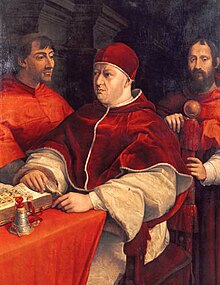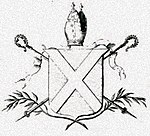Innocenzo Cibo
Innocenzo Cybo | |
|---|---|
| Archbishop of Genoa | |
 | |
| Church | Roman Catholic Church |
| Archdiocese | Genoa |
| Appointed | 11 May 1520 |
| Term ended | 14 April 1550 |
| Predecessor | Giovanni Maria Sforza |
| Successor | Gerolamo Sauli |
| Other post(s) | Cardinal-Deacon of Santa Maria in Via Lata |
| Previous post(s) | Cardinal-Deacon of Santa Maria in Domnica (1517-1550) Cardinal-Deacon of Santi Cosma e Damiano (1513-1517) |
| Orders | |
| Created cardinal | 23 September 1513 by Pope Leo X |
| Rank | Cardinal-Deacon |
| Personal details | |
| Born | 25 August 1491 |
| Died | 14 April 1550 (aged 58) Rome, Papal States |
| Buried | Santa Maria Sopra Minerva |
| Parents | Franceschetto Cybo and Maddalena di Lorenzo de' Medici |
| Children | 4 |

Innocenzo Cibo (25 August 1491 – 13 April 1550) was an Italian cardinal and archbishop.
Family and education
From the Genoese family Cibo,[1] in 1488 the Cybo family purchased Florentine citizenship for a considerable sum of money [2] Innocenzo was born in Florence on 25 August 1491[3] to Franceschetto Cybo and Maddalena di Lorenzo de' Medici. His father was the illegitimate son of Giovanni Battista Cibo, who became Pope Innocent VIII (1484–1492),[4] and had five additional children: Lorenzo, Caterina, Ippolita, Giovanni Battista and Pietro.[5] Francesco's sister, Theodorina, married Gerardo Usumari, a rich Genoese.[6] Innocenzo's mother was the daughter of Lorenzo the Magnificent and sister of Piero de' Medici, Giovanni de' Medici, who became Pope Leo X (1513–1520), Giulio de' Medici, and three other sisters. Her first cousin, Giulio de' Medici, became Pope Clement VII (1523–1534).
He was presumably educated at the Medici court.[citation needed] When his uncle Giovanni de' Medici was elected pope in March 1513, benefits flowed even more abundantly to the Cybo.
Cardinal and archbishop
On 17 March 1513, the day on which Leo X was consecrated a bishop, he made Innocenzo a Protonotary Apostolic [7] In Pope Leo's first consistory, 23 September 1513, he was made cardinal deacon of SS. Cosma e Damiano. He exchanged this deaconry for Santa Maria in Domnica on 26 June 1517. On 11 May 1520, he was made archbishop of Genoa by the favour of his uncle Pope Leo X. For a brief three months in 1521 he was Cardinal Camerlengo of the Holy Roman Church but was 'allowed' to sell the office for the sum of 35,000 ducats to another of Leo's favourites, Cardinal Francesco Armellino de' Medici[8]
He accumulated the rights of administration over episcopal sees, e.g. St Andrews (13 October 1513—13 November 1514),[9] Marseille, Aleria in Corsica (19 June 1518 – 19 December 1520), Ventimiglia (27 July 1519 – 8 August 1519) and numerous others, most for brief periods of time.
He participated in the 1521–1522 papal conclave, and, even though (or perhaps because) he was ill and had to cast his vote from his sickbed, he came close to being elected pope. Once his name was suggested he managed about twenty votes, apparently from the younger cardinals, those desirous of continuing the habits of the court of Leo X.[10]
King Francis I of France appointed him Abbot of Saint-Victor of Lerins in 1522, hoping, no doubt, to strengthen the French interest in the College of Cardinals after the election of the minister of Emperor Charles V to the papal throne as Adrian VI. He was also granted the Abbey of St Ouen in Rouen.
In 1524 he was made Legate of Bologna and the Romagna. In 1529 and 1530, he was the host of both Emperor Charles V and Pope Clement VII in Bologna, and he participated in the coronation of the Emperor on 24 February as Archdeacon. At the conclusion of the ceremonies, he and Cardinal Ippolito de' Medici accompanied the Emperor on his homeward journey as far as Mantua.[11]
Just before the Sack of Rome of 1527, he took refuge in Massa Carrara, host of his sister-in-law and mistress Ricciarda Malaspina, by whom he had four children, who were later naturalized.
A report to the Venetian Senate, written by Antonio Sorano, its ambassador at Rome, on 18 July 1531, provides an analysis of Cardinal Cibo, as his assignment required. He stated that Cibo was not a person of grand affairs nor of deep thought, but too immediately given over to worldly pleasures and to some lasciviousness. Pope Clement did not seek his counsel on matters of state.[12]
In 1532 and 1533 Cardinal Cybo was sent by his first cousin Clement VII, to govern Florence during the absence of Duke Alessandro de' Medici. He was one of the four Cardinals appointed executors of Pope Clement's Will[13] At the conclave following Clement's death, he had hopes of the papacy, but was eclipsed by Paul III,[14] and subsequently he decided to return to Florence.[15] But here his relationships with the Grand Duke Cosimo I de' Medici deteriorated, and he moved again to Massa Carrara in 1540. Two years later his loyalty to the Imperial cause was rewarded with the title of Cardinal Protector of Germany.
In Rome, the Cardinal had his residence in Palazzo Altemps. He returned to that city in 1549 to take part in the Conclave following the death of Pope Paul III (Farnese).[citation needed] The favoured candidate was Reginald Pole, but Giovanni Maria Ciocchi del Monte, Julius III, was elected.[16] As senior Cardinal Deacon Innocenzo Cibo crowned Pope Julius III on 22 February 1550. On 28 February 1550, he exchanged the Deaconry of Santa Maria in Domnica for that of Santa Maria in Via Lata. He died on 13 April 1550, according to his tombstone, at the age of 59 and having been a cardinal for 37 years. He was buried in the Basilica of Santa Maria sopra Minerva, in the centre of the Choir, behind the High Altar, between the monuments of his uncle Leo X and his cousin Clement VII.
Notes
- ^ See Giuseppe Moroni, Dizionario di erudizione storico-ecclesiastica Volume 13 (1842) pp. 121-125.
- ^ Luigi Staffetti, Il cardinale Innocenzo Cybo (Firenze 1894) 14 n. 2.
- ^ Staffetti, 12.
- ^ Illegitimate son: Johannis Burchardi Diarium (ed. L. Thuasne) Volume I (Paris 1883) 321 n.1. Mandell Creighton, A History of the Papacy Volume III (London 1887) 120.
- ^ A manuscript written in 1548, now in Florence in the Magliabech collection (XXVI no. 16) gives the series genealogica familiae Cibo. See Achille Gennarelli (editor), Johannis Burchardi Argentinensis ... Diarium ... (Firenze 1854) p. 196.
- ^ Burchard 422. The ms. cited by Gennarelli lists the five children of Theodorina: Giovanni Battista, Francesco, Batistina, Aranino and Peretta.
- ^ Marino Sanuto Diario Volume 16, col. 57.
- ^ Luigi Gradenigo, the Venetian Ambassador, in Relazioni degli ambasciatori veneti al Senato Series II Volume III (edited by Tommaso Gar), Roma (Firenze 1846) p. 71; Lorenzo Cardella, Memorie storiche de' cardinali della Santa Romana Ecclesia Volume IV (Roma 1793) p. 8, pp. 40-41.
- ^ He was never Bishop of St Andrews, only Administrator. He was not in episcopal orders. Guilelmus van Gulik & Conradus Eubel, Hierarchia catholica medii et recentioris aevi III, editio altera (Monasterii 1923), p. 108. David M. Cheney, Innocenzo Cardinal Cibo (Cybo). Retrieved: 2016-04-04.
- ^ F. Petruccelli della Gattina, Histoire diplomatique des conclaves Volume I (Paris: 1864), 520-521. The story derives from a letter written by Giovanni Maria Galiani from Rome on 10 January 1522, the day after the Conclave ended. It is quoted in Staffetti, 35-36 n. 1, who uses it and the Memorie della famiglia Cybo, a family history written by order of Prince Alberico Cybo, to advance the notion that Cardinal Innocenzo was an active candidate. This is highly unlikely since Cardinal Giulio de' Medici was an active candidate, already supported by the Florentines.
- ^ Gaetano Giordani, Della venuta e dimora in Bologna del Sommo Pontefice Clemente VII. per la coronazione di Carlo V. Imperatore (Bologna 1842) p. 179
- ^ Eugenio Alberi (editor), Relazioni degli ambasciatori veneti al senato Volume VII (Serie IIa, Volume IIIo) (Firenze 1846), 279: Questo cardinal Cibo non è persona di grande affare nè di alto spirito, ma più presto e dedito ai piaceri mondani e a qualche lascivia. È ricco di forse ventiduemila ducati d' entrata, e il papa non si serve di lui in consiglio, quanto a cose di stato; ma solo da molti anni nella legazione di Bologna. È stato popo alla corte in tempo mio; nè posso perciò molto estendermi in parlare di lui. Questo non voglio tacere obe nello andare alla mia legazione in Fiorenza [1527], lo visitai passando in Bologna, e da quel poco di maneggio che ho avuto con lui, l' ho ritrovato, col fratello Giovanni Bartolomeo, molto amorevole di Vostra Serenità.
- ^ The executors of his Last Will and Testament were Cardinals Innocenzo Cibo, Ippolito de' Medici, Nicolo Ridolfi, and Giovanni Salviati (F. A. Artaud de Montor, Histoire des souverains Pontifes Romains Volume IV (Paris 1851) 114).
- ^ Notes on Conclave of 1534, Dr. J. P. Adams.
- ^ Staffetti, 127-130, attempts to make a case, based on the observations of Feliciangeli, that Cybo was a candidate, but the documentation is very weak, and the story is not in agreement with the other known facts of the election. Cardinal Farnese, who had a prior understanding with Cardinal Ippolito de' Medici, Innocenzo's relative, for Florentine support, was named pope by acclamation.
- ^ Notes on Conclave of 1549-1550, Dr. J. P. Adams.
Further reading
- Dowden, John, The Bishops of Scotland, ed. J. Maitland Thomson, (Glasgow, 1912)

